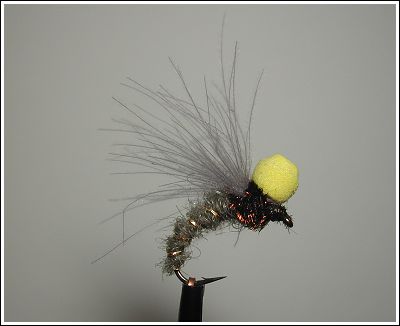|
Roncallo Special
By Agostino Roncallo

Brown Roncallo Special
This
is one of the first artificial flies in which assemblage I inserted the
CDC. Arose from a modification that I made to Suspender Nymph by John
Goddard and Brian Clarke. After the publication of the book "The Trout
and The Fly. A New Approach”, their Suspender Nymph became known to the
Italian fishermen who appreciate quality.
This nymph falls in the surface
film of water by a ball of foam, wrapped in a strip of nylon stocking,
fixed next the hook eye in imitation of the wing pouch. At that time, I
did not know what was the foam, so wrap a ball of polystyrene, dyed
black with a pen, in a strip of plastic film. I replaced the plastic
film with the nylon stocking because I felt better imitate the wing
pouch of the nymphs are ready for hatching.

Imitation worked very well, but I had a
problem: I could not see it easily in water, often lost sight of the
fly, and hooked the fish to late.
I modified it by adding a bunk
of CDC next to polystyrene ball and things improved. Later I replaced
the polystyrene ball with a foam ball reaching the final criterion for
construction of imitation.
The idea to call the fly "Roncallo Special" was my
friend Claudio Tagini's, that lives in USA and that with this fly has
caught all kinds of fish: bass, blue gills, trout, Steelheads and
salmon.
Tying description:

1) From a foam sheet of a
centimeter of thickness, using clamp with which you make holes in
leather, I income a cylinder and, with scissors, I give rounded a tip.
2) Lock the vice a hook grub and
start to wrap the assemblage thread around its shank, starting from eye.
Proceeding to the left to tight turns up to half of the stem, turning
back and I stop just before the eye, the point where I have to fix the
foam ball. To get the ball of foam, positioned on the shank of foam
cylinder with round ends next to the eye, in order to get the ball
attachment.
3) After creating the ball, I
move the assemblage thread to the left by pressing and fixing on the
stem a few millimeters of foam cylinder. Cut the excess foam cylinder
and proceed with winding thread around the shank of mounting until
reaching the point where I will begin to build the abdomen imitation.
4) At that point, a fixed on the
assemblage thread hare hear or synthetic yarns that wrap for create a
dubbing to wind around the shank for build the body of imitation.
5) Proceed with the construction
of the body to reach the ball of foam , beside which a fixed s Hackle
CDC. wrap the hackle around the ball in position and after having
parachute attached to the shank of the hook, I cut the surplus.
6) I take the barbs of the CDC,
move it to the left and lock in that position, crossing the wire
assembly on the sides of foam ball.
7) Next to the foam ball, I
fixed three herls of the peacock feather tail, the twined about
themselves, wrap around the hook crossing between the CDC wings and the
ball to get the chest of imitation, fixed the herls next to the eye and
cut their surpluses. I finish the installation by running the head of
the fly which I put a drop of paint.
Usually, to create the ball of
imitation I use yellow foam because it is the color that I see better in
water. The fly could also be built deprived of the chest of peacock
herls without to damage his effectiveness.
The Roncallo Special is perhaps the
most eclectic of my imitation, either dry or wet floats and works in all
types of water, high in the streams, rivers and lakes. In waters where
the fish are subjected to high fishing pressure, especially in no-kill,
where they are often attacked by small flies and capillary nylon, a
Roncallo Special built on a hook No. 12, often catching very well,
happened more than once and into difficulty waters.

Grey Roncallo Special

Pink Roncallo Special

Old Roncallo special
Text and
photos by Agostino Roncallo © 2010
|